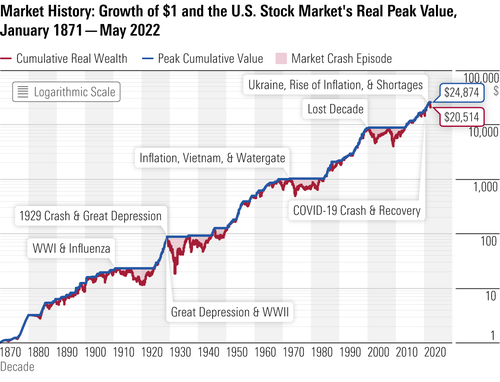
In our 2022 outlook, we noted that the U.S. stock market was overvalued coming into the year and that it would need to contend with four main headwinds: slowing economic growth, tightening monetary policy, rising interest rates, and high inflation. During the second quarter, the confluence of these four headwinds pushed markets down deep into undervalued territory.
Based on a composite of the intrinsic valuation of all the stocks we cover that trade on U.S. exchanges, we calculate that the broad U.S. stock market is trading at a price/fair value of 0.83 times. Growth stocks are the most undervalued, trading at a price/fair value of 0.78, followed by the value category trading at 0.83. Core stocks are trading closer to fair value at 0.91 times.
Across capitalization levels, large- and mid-cap stocks are trading near the broad market valuation, whereas small-cap stocks are trading at the greatest discount to fair value at 0.68.
Over the past quarter, most of our intrinsic valuations either held steady or increased. Across our coverage, we lowered our fair value by more than 3% on only 18% of our coverage. There were only a few significant downgrades, where we reduced our fair value more than 10%, representing 7% of our coverage. Considering the core category is closest to fair value, we see the best positioning for investors in a barbell portfolio between growth and value.
Morningstar Equity Research Coverage Price/Fair Value

- Source: Morningstar Equity Research. Data as of June 27, 2022.
Since 2010, Stocks Have Rarely Been This Undervalued
The current level of undervaluation is the greatest discount to our long-term, intrinsic valuations since the emergence of the pandemic in March 2020 and the growth scare that sent stocks lower in December 2018.
On a longer historical time frame, the only other instance when our price/fair value metric had dropped lower was in the fall of 2011, when there were concerns that possible contagion from the Greek debt crisis was spreading to other countries (Portugal, Italy, and Spain) and that the systemic risk from the European sovereign debt crisis was spreading to the European banking system. The markets were close to this level in mid-2015/early 2016, when U.S. equity markets fell as declining economic growth in China and plunging oil prices took their toll on market sentiment. At current valuations, we think the market is overly pessimistic regarding the economic outlook.
Deep Undervaluation Found Across Cyclical and Sensitive Sectors, Whereas Defensive Remains Fairly Valued
Communications remained the most undervalued sector and consumer cyclicals the second most. The valuation of the communications sector is skewed by the sheer size of the market capitalization of 4-star-rated Alphabet (GOOGL) and 5-star-rated Meta Platforms (META). Yet, even after accounting for this, communications remains the most undervalued sector, both from the perspective of the greatest number of undervalued stocks as well as the greatest discounts to our fair values. We see a significant number of undervalued opportunities in both traditional and nontraditional communications and media stocks.
Concerns of a possible near-term recession sent consumer cyclical stocks plunging during the second quarter. Yet, we think the market is overreacting, as we do not project a recession occurring in the near term. In the event of a recession, we think that the sector already factors in enough of a margin of safety, as it currently trades at a 25% discount to our fair value. Many of the services-oriented companies in this sector should benefit as the pandemic continues to recede and consumer spending returns to normal and shifts back to services and away from goods.
Oil prices peaked in early June and began to moderate over the rest of the month. Energy stocks followed suit and slipped lower during the second quarter. Following this pullback, we now view the energy sector as fairly valued.
All of the defensive sectors are fairly valued, with utilities skewing a little overvalued. Although we expect inflation will begin to moderate later this year, if it remains more persistent, utilities would be the most negatively affected sector.
Price/Fair Value by Sector

- Source: Morningstar Equity Research. Data as of June 27, 2022.
Undervalued Wide-Moat Stocks Are Especially Compelling
Year to date, companies with a wide Morningstar Economic Moat Rating have fallen slightly more than the broad market. The Morningstar Wide Moat Composite Index has dropped 19.90% compared with the 18.75% decline of the Morningstar US Market Index. However, when you apply a valuation overlay to wide-moat stocks, such as the Morningstar Wide Moat Focus Index, this index has significantly outperformed the broader market, having dropped only 10.90%. Overall, the market is undervaluing wide-moat companies, which are trading at a 22% discount to fair value.
We also believe that in addition to being able to generate excess returns on invested capital over the long term, wide-moat companies generally have greater pricing power. As such, they should be able to pass through any cost increases to clients and be able to better maintain their margins and thus maintain their valuations in an inflationary environment.
Price/Fair Value by Moat Rating

- Source: Morningstar Equity Research. Data as of June 27, 2022.
What to Do Now?
In these types of market environments, it is especially important for investors to have a plan that balances their long-term investment goals with their risk tolerances. This plan should also allow for periodic rebalancing to increase equity allocations when valuations decline but also reduce exposure when valuations become overextended. Based on our view that the U.S. equity market is undervalued, we think that now is not the time to be reducing equity exposures but to be adding judiciously—especially in companies with wide economic moats—based on your investment plan and goals.




















